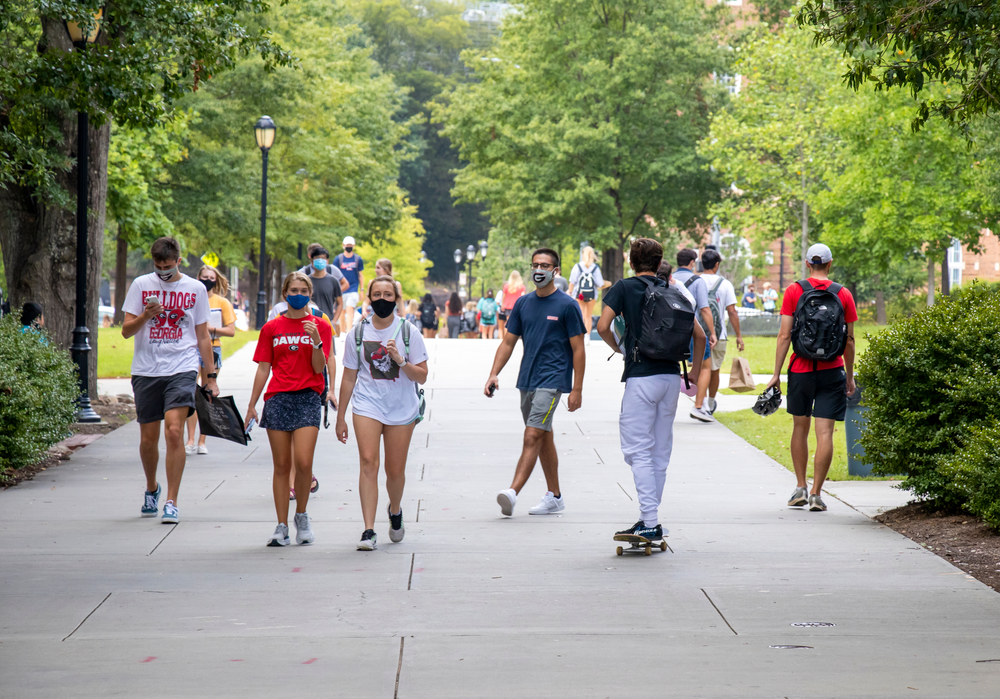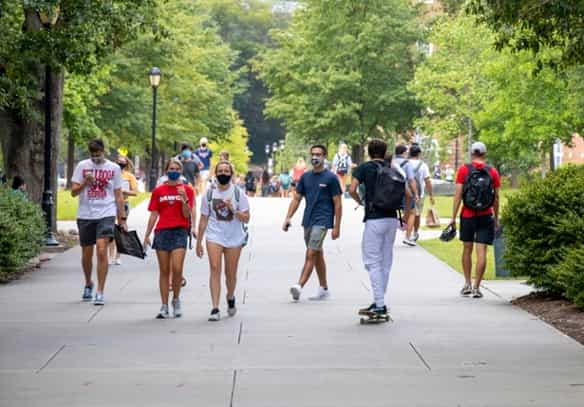- SERVICES
- HIGHER EDUCATION MARKETING
- ENGAGEMENT & ENROLLMENT MANAGEMENT
- STUDENT RECRUITMENT AGENCIES
- PROFESSIONAL EDUCATION & TRAINING
- WHO WE ARE
WHO WE ARE
Learn more about Keystone Education Group, including our leadership structure, why choose Keystone as your educational partner, and company press releases.
QUICK LINKS
- RESOURCES
RESOURCES
Find a range of helpful resources to help with your educational marketing. From on-demand webinars, reports & data, to customer testimonials and our downloadable media kit.
QUICK LINKS
- NEWS
- REQUEST A CALL

- Keystone Higher Education News
- 2020 in Higher Ed: A Year In Review

As we near the beginning of a new year, now is a good time to reflect upon the unprecedented and unforgettable year that was 2020. While the COVID-19 pandemic has brought some unexpected curveballs for educators and students alike, it has forced the sector to innovate and introduce new learning pathways. Higher education was deeply impacted by the many changes brought by COVID-19, but amongst the disruption and uncertainty, there was also opportunity and potential for innovation to be found. Together, we made it through and as we bid farewell to 2020, we look forward to a brighter future in 2021.
Written by Elise Hodge, Chelsea Castonguay Stanhope and Kristine Meek Stokke
The sudden switch to virtual learning
The spring semester of 2020 didn’t go exactly as planned for many students. As the virus began to bloom on campuses around the world, administrators scrambled to determine what would be the best course of action to keep students on a path to earning their degree. Schools began emptying out as they sent students home to shelter in place, and lessons rapidly moved to the cyber world. Where previously around 13 percent of all students were enrolled as online students, all of a sudden every student was an online student, and every professor had to trade their classroom for their living room.
Where online classes continued, adjustments were made to provide a more high-touch experience. Some of the methods that have been introduced include encouraging students to engage during classes, utilizing break-out rooms, providing personalized videos, and offering office hours. These small changes in response to student feedback helped to support students as online learning continued.
While this helped students stay on track, it proved difficult in some aspects. Faculty often struggled with the rapid transition, and some students found online learning challenging. From faulty internet access to Zoom-issues, it took awhile to work out the kinks with online learning. However, as we are finishing the second semester of schools dealing with COVID-19, more students and faculty are learning how to continue on with their education. From this experience, opportunities for collaboration, patience, and resilience were inspired, giving all a chance to refocus the meaning of education.
Travel and international students
One of the reasons some students opt to attend university is for an opportunity to travel and experience a new country, city, or culture. However, with the world essentially shutting down for the past twelve months, this has made travel impossible for some students, changing their study abroad plans. With shutdowns happening rapidly in the spring, international students scrambled to get home before they became stranded in their host country, and schools struggled to figure out how to make up the lost revenue from their international student population. In May 2020, wenr.wes.org surveyed 615 students from 92 countries, from all types of higher education institutions. Of these students, 53% surveyed felt the pandemic wouldn’t stop them from studying abroad. However, for countries unable to get the pandemic under control, the risk of students choosing to pursue studies elsewhere is significant, with 23% saying they would change their study abroad plans if COVID-19 restrictions were still in place.
Watch video: How will the US presidential election impact international student recruitment in 2021?
Student health and wellbeing
The uncertainties of the last year have taken their toll on college students. A study published in the Journal of Medical Internet Research indicated that out of 195 American students enrolled at large universities, 138 (or 71%) “indicated increased stress and anxiety due to the COVID-19 outbreak.” Many students reported external stressors beyond that of switching to remote learning; students feared for the safety of themselves and their loved ones, struggled with social isolation, reported disrupted sleep patterns, and were concerned about their academic success. While self-care is one of the frequently recommended coping strategies, out of 2,086 college students surveyed by activeminds.org, 73% reported it was difficult to find ways to stay active.
However, according to this same study, students are taking control of their physical and mental health, and seeking support from peers. Online interactions are on the rise, as students reach out to one another and the families to connect over the internet. In response, universities have begun adapting the way they support students by moving many traditional services online. Counseling, programming, exercise programs, and other services have all been made available to students via the Internet.
Digital internships open new doors for experience
One of the main areas that has been impacted is internships. This has been challenging for students who need to gain the necessary skills and experience to apply to jobs. However, as a solution, universities have pivoted and partnered with organizations to offer students digital internships. There are currently thousands and thousands of digital internships available on LinkedIn, Indeed, WayUp and The Intern Group, offering students the opportunity to apply to positions they otherwise may not be able to due to location restrictions.
Traveling and exchange programs put on pause
Unsurprisingly, study abroad programs have been one of the biggest areas to be hit. Travel and visa restrictions due to heightened health risks, saw many students forced to return home from. Where some 15 percent of students would typically engage in overseas study, the COVID-19 Pandemic has seen participation in study abroad programs drop to an all-time low across the board.
Due to these travel restrictions, many universities have partnered to provide students with virtual exchange programs. While these programs are not entirely new, they have never been offered as the primary mode of gaining access to an international university. However after this year, these programs may be established more permanently in course curriculums. In many cases, virtual exchange programs allow for students from different backgrounds to come together and learn about each other’s culture. They also serve the benefit of allowing more students access to an international setting, regardless of their financial circumstances.
However, there is no doubt many students are looking forward to traveling overseas in the coming years. Keystone’s State of Student Recruitment report found that a great percentage of students are not turned off by international travel, and want to travel abroad despite the pandemic, with many students eagerly waiting for international borders to open and physical restrictions to ease.
What did we do well and what can we learn?
It’s easy to feel disheartened by the past year. However, it wasn’t all bad. Some colleges took the challenges presented by COVID-19 and found opportunities to fight back. Many universities opted to give students extended grace periods to drop classes without academic repercussions, while others switched to pass/fail options. Widespread testing across campuses and quick quarantining of those affected by the virus also helped minimize the amount of spread across some universities, allowing students to continue in person studies. Cornell University’s president Martha E. Pollack attributed the Ivy League school’s low numbers to be the result of “massive testing.”
Going forward, we can learn from schools that did well during openings, and use schools that failed a cautionary tale. Where some schools have managed to maintain relatively low virus counts due to increased awareness, testing, prompt quarantining of sick students, and social distancing, those that opened too quickly found themselves the subject of criticism as cases bloomed on their campuses. Continuing to encourage hybrid or remote learning, keeping students safe on campus with mask mandates and social distancing measures, as well as a frequent testing protocol seems to be the best recipe for success.
Looking towards 2021, there are a few pieces we can look back on from 2020 to help inform our decisions going forward into 2021. International student recruitment is going to continue to be a struggle for many countries, but this guide can help you determine the best course of action.
As students and faculty continue adapting to the ever-changing world of education during a pandemic, continuing to go forward with grace, kindness, and understanding for one another will be critical. Therefore, making virtual learning more interactive, and remembering what we learned during the 2020 academic year can be helpful for the future, no matter what it may bring.
Looking towards a new year
While life for many students around the world may not completely return to “normal” for some time yet, there is potential for digital learning to remain a fundamental part of higher education. With this in mind, universities and colleges should continue to adapt to student needs, and equip themselves with understanding the latest in disruptive technologies. As 2020 comes to a close, there is one thing we can know for sure: the universities that continue to adjust to the digital landscape will be the ones that stand to reap the benefits in the long term.
Finally, if you’re thinking about where students and universities stand as the year ends, a great frame of reference is Keystone’s State of Student Recruitment 2020 report. This extensive report shares insights from over 20,000 university students, and more than 800 student affairs professionals. This report will give you the leg up when planning the best ways to recruit and retain students in the upcoming year.
2020 has left what is sure to be a long-lasting impression on the world, and has helped reshape our expectations for higher education in the future. However, despite these challenges, students and staff have continued to rise to the occasion, and demonstrate the strength of human resilience. Here’s to saying goodbye to 2020, and welcoming 2021 with open arms.
More about:
Related Tags
Just For You
Top Picks
Higher Ed Chats Podcast
Listen to the latest episodes of our Higher Ed Chats Podcast - new format for 2024. Hear from Higher Ed thought-leaders from around the world!

Webinar: Dos & Don'ts of Higher Ed Social Media
.png?width=500&name=Social%20Media%20Webinar%20March%2024%20Banners%20(3).png)
Join our live webinar on 27th March to hear from a panel of Higher Ed Social Media experts.
Subscribe
to get the latest news and updates
-1.png?width=348&name=Copy%20of%20linkedin%20presidents%20(1)-1.png)





